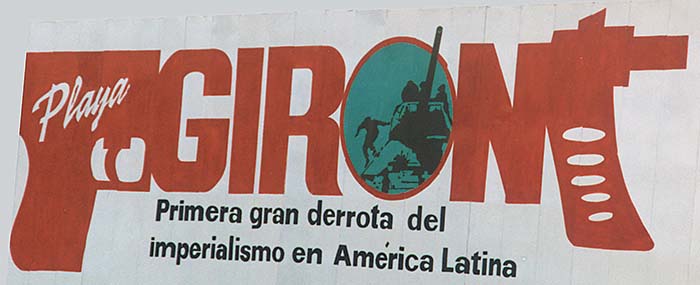Propaganda billboard at the Bay of Pigs: “Playa Giron, the first great defeat of imperialism in Latin America.” The inset in the ìOî depicts a famous scene of Castro jumping from his SAU-100Soviet self propelled assault gun.
By Rob Krott
“No, no, los mercenarios were Yanquis…not Cubanos!” This was just one of the small bits of propaganda I heard on my first visit to Cuba. With me (and sharing my incredulity at such statements) was my old friend, Jerry Lee, a paratrooper and military police reservist. “The Guner,” as he’s known works in the auto industry and moonlights as a rock n’ roll radio D.J. A talented machinist he has legally built his own 1919 Browning and can be counted on to troubleshoot any Class III weapons mechanical problems.
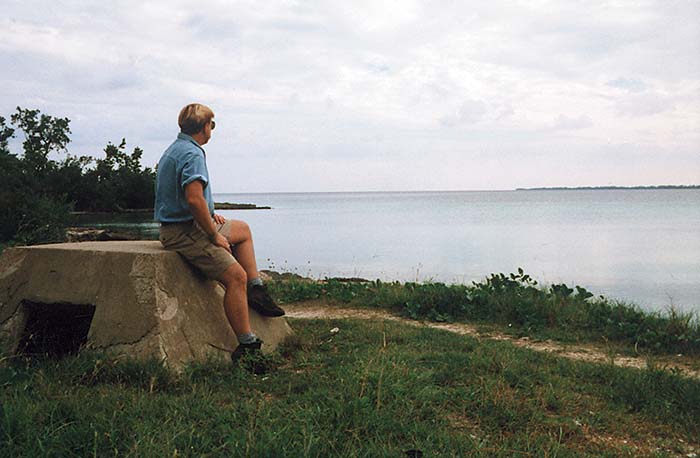
Death to the Yanqui Imperialists!
Having read our history including Jerry’s copy of The Bay of Pigs: the Leaders’ Story of Brigade 2506 by Haynes Johnson, we wanted to see the landing site first hand. Slipping the driver and the tour guide $10 each we were happy to leave the other tourists behind. While they were swimming at Playa Larga, which sits at the head of Bahia de Cochinos, the Bay of Pigs, we took a dip in Cold War history. It was a twenty minute drive to the Bahia de Cochinos, known to most Cubans as Playa Giron after Gilbert Giron, a French pirate who landed there in the 17th century. We skirted the Parque Nacional de la Cienega de Zapata (Zapata Marshlands Park) a largely unspoiled wilderness home to 80% of Cuba’s fauna, including large numbers of crocodiles. Playa Larga sits at the head of the Bay of Pigs. It was here that a CIA backed Cuban-exile force, Brigade 2506, invaded Cuba on April 17, 1961. Denied sufficient air support by President Kennedy, the invasion failed. Most of the men of Brigade 2506 were either killed or captured. Many were subsequently executed. A few attempted to traverse the crocodile infested salt water marshes of the Cienega de Zapata and perished. After the invasion a subsequent attempt by the Soviets to emplace nuclear capable medium-range ballistic missiles in Cuba provoked the Cuban Missile Crisis of 1962.
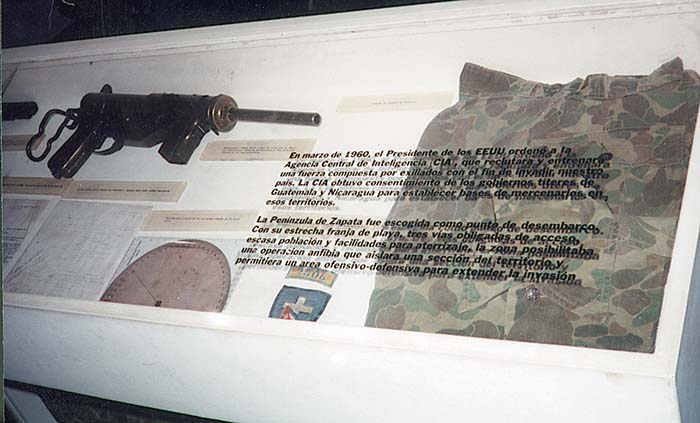
The government built a museum, the Museo de Giron to commemorate the Cuban victory over the American imperialistas and their Cuban “mercenaries.”{The Cuban exiles of Brigade 2506 are identified in the museum exhibits as belonging to the “Organizacion de la Brigada de Asalto 2506 (mercenaria).”} Along the side of the road on the way to Playa Giron is a propaganda billboard commemorating the Bay of Pigs invasion. “Playa Giron, primera gran derrota del imperialismo en America Latina” (Playa Giron, the first great defeat of imperialism in Latin America). An inset depicts a famous scene of Castro jumping from his Soviet self propelled-assault gun – a popular motif in the area. Parked in front of the museum is a British made Sea Fury prop-driven fighter plane used by Castro’s air force to attack the Cuban-exile invasion force on the beach during Bay of Pigs. They also played hell with the B-26s meant to support the invasion.
Walking past the Sea fury and a Cuban flag fluttering in the breeze we bought a ticket and entered. We toured the museum along with a group of Cuban school-kids wearing red scarves of the Communist Party’s Young Pioneers. More than one tugged a schoolmates sleeve and whipered “Yanquis” or Imperialistas.” Here, away from the tourist traps of Varadero Beach and Vedado (Havana) the Cubans take their political history very seriously.
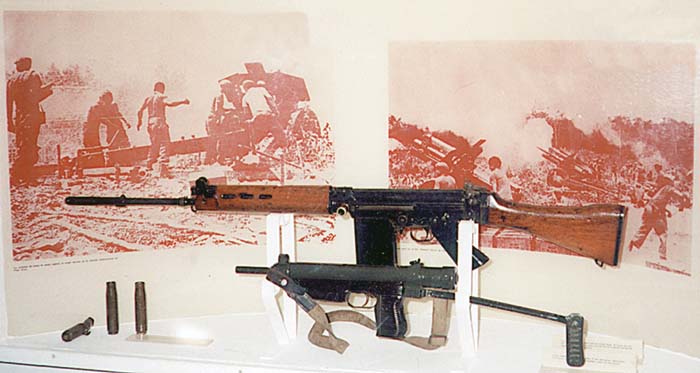
Photographs of the Cuban soldiers (actually local militia men) killed in the fighting dominated the exhibits, taking up one whole wall. Display cases were filled with many of their personal effects; uniforms, sidearms, berets, and insignia. Weapons captured in the invasion and those used by Cuban forces along with various items of field gear filled the rest of the museum. So, as small arms aficionados who collect uniforms and militaria we were in heaven. Jerry was pleased to confirm from a display that the Cubans of Brigade 2506 wore 1950s USMC issue 13 star button “Duck Hunter” camouflage uniforms while I ogled an authentic 2506 insignia (a Cuban flag superimposed on a white cross) with tab. Studying the photos of militia men being issued weapons still covered with packing grease Jerry and I determined that the Milicias, Nacionales Revolucionarias were armed with a hodge-podge of Beretta M-1 Garands, Springfield 1903s, Krag 1896 rifles (#31640 is on display at the museum), early FN FAL 7.62mm rifles, and even a Remington .45 auto pistol. Mainstays were 7.62 Model 52 Czech rifles, Soviet PPSh-41 submachine guns, and Model 23 Czech 9mm subguns – all hastily “purchased” by Castro’s government from the Warsaw Pact and hurriedly issued to the mostly untrained milicianos of the Cuban Militia. While not the best choice of available combat small arms at that time, they were well suited for use by illiterate peasants. The PPSh-41 is a simple design and even simpler to operate while the Model 52 and model 23 are both excellent designs. The Model 23 submachine gun shares many unique design features with the Uzi. With its extremely simple assembly / disassembly sequence it could be issued to untrained militia men with only a brief period of orientation and instruction. A 9mm submachine gun doesn’t require much in the way of marksmanship training either!

Similar to the German MKb42(W), the Czech Model 52 (Czech 7.62mm) – the Czechs copied the Walther designed MKb42’s unique gas system – is semi-auto and thus not a true assault rifle. However, with its 10 round detachable box magazine and heavy caliber it was a match for the Brigade 2506 soldiers equipped with .30 caliber M-1 carbines and 8 round M-1 Garands.
Of course there were also a number of M-2 carbines, M-1 rifles, and Colt .45 auto pistols courtesy of the U.S. Army via Fulgencio Batista’s armory in use by the Cuban militia men. Colt .45 ACP 1911 pistols were used extensively on both sides of the Cuban revolution and were much admired and coveted. Castro is known to have carried a .45 during the revolution (along with a Model 70 Winchester hunting rifle) and supposedly had the same piece with him at the Bay of Pigs. A photo taken by Lester Cole in Havana a few days after Castro’s triumphant overthrow of the Batista regime shows Castro wearing a .45 M1911. The robust, dependable pistols continued to be pressed into service by many Cuban soldiers until widespread issue of Soviet weapons began. Several of the M1911’s which I’ve seen in Cuban museum collections boasted custom grips and were well maintained – not an easy job in the tropics.

But, the invading exiles were armed with more than carbines and pistols. Since the Brigade’s task was to secure a beachhead and move inland, eventually driving on to Havana (how this was envisioned given the poor roads and distance to the North coast still puzzles me) the weapons platoons were all equipped. Heavy weapons captured in the invasion and now on display included an M-30 4.2 “Four Deuce” mortar, a 75mm recoilless rifle for anti-tank work, and a Browning .30 caliber machine-gun. A heavy automatic weapon used by the Cuban militia, a Czech model 37 (ZB53) 7.92mm heavy machine gun – the forerunner of the British-made Besa tank machine-gun – got me in trouble with one of the museum matrons when I disengaged the quick change barrel handle/barrel locking mechanism. “Just czeching”, I told her.
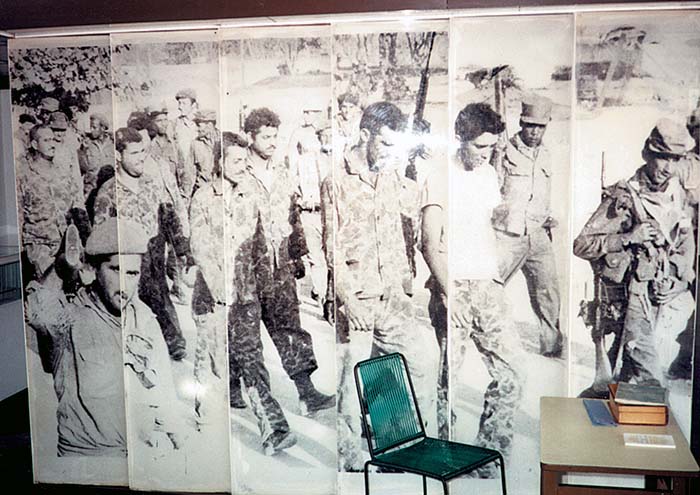
It’s no wonder Model 37s were used by Castro’s forces on the beach at the Bay of Pigs as the Model 37 was manufactured in large numbers expressly for export. The ZB-37, also known as the Model 53 (ZB-53) has a slow rate of fire (500 rpm) or a faster (700 rpm) rate of fire depending on the selector. With a right-hand feed of 100 or 200 round metallic link belts this 7.92mm heavy machine-gun proved itself a dependable work horse in combat theaters around the world. Also on display was a four-barreled anti-aircraft gun (which I believe was an early ZSU-23-4) – it would have been a real terror in the ground support role if it was used to sweep the beach. It may also have contributed to the shoot down of the B-26s lost during the invasion, although that is only speculation. The caretakers of the museum were very helpful and surprised to see the amount of time and attention we paid to the exhibits. I don’t think they get too many American military veterans down here.
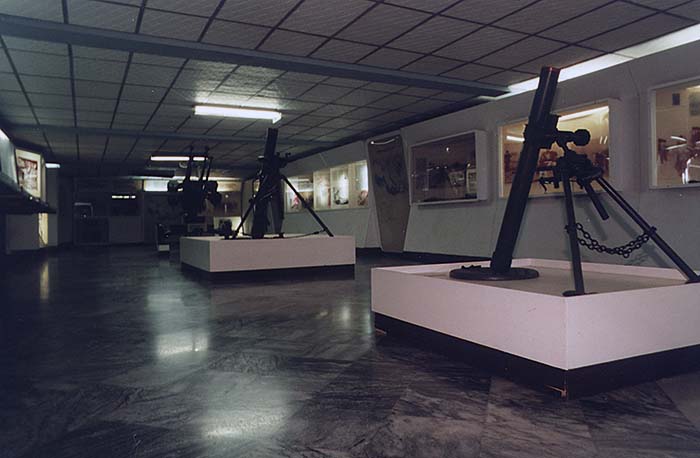
On the way back to Varadero we stopped in Australia, a town named for its sugar mill’s parent company. We jumped out of the minivan and started looking for Castro’s old command post during the Bay of Pigs. We knew it was here in Australia from the history books and because there was a billboard along the side of the road announcing it. “aqui esta comandancia de las FAR”(FAR-Fuerzas Armadas de Revolucion – armed forces of the revolution). Finding the actual building used as Fidel’s command post took a little wandering, though it was only a block from the sign. Everybody, except our tour guide, knew where it had been. There we found a small collection of old rifles including two Winchesters and a Remington rolling block. Both were probably used in the Spanish-American War.
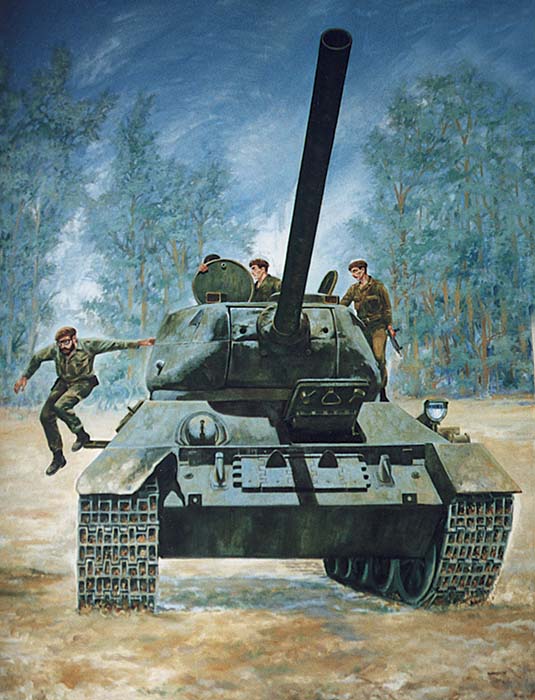
I thoroughly enjoyed my first visit to Playa Giron. Besides visiting the museum and walking along the beach, there was an inherent thrill just being there – on the ground in the country which is America’s last, closest and most defiant cold war foe.
Rob has made 3 subsequent visits to the Playa Giron Museum. For additional reading on the Bay of Pigs see: The Bay of Pigs; the Leaders Story of Brigade 2506, Haynes Johnson, et al W.W. Norton Co. 1964, 1st edition.
| This article first appeared in Small Arms Review V3N7 (April 2000) |



